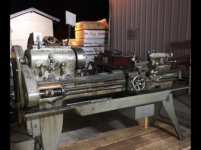Ethanhagle
Plastic
- Joined
- Feb 11, 2020
- Location
- Somis, Ca
This is my first post here, I’m an amateur fabricator with a desire to get things done using my own resources. I’ve been watching machinist videos for a long time and never actually got my hands on any actual machinery. Anyhow I finally pulled the trigger on something I could afford, this Le Blond lathe along with a Bridgeport J Head Mill. I got them both for $1500. (Yes I had him demo everything before I handed over the cash). I’ve been patiently waiting to expand the garage over at my dads house, and after a year we finally got the room expanded and brought in the machinery. Now I’m just waiting to have my buddy come over to upgrade our panel.
The reason for this post is just to ask for some advice on what sort of beginners tooling I should invest in that you wish you would have had someone tell you about in the beginning. Along with common mistakes on setting up. I also have a friend who has a machine shop that’s all CNC units, luckily he has lots of scrap aluminum to practice on and some old vises, unfortunately he doesn’t have any knowledge on running manual machinery.
I’m hoping to get into crafting my own shotguns someday. (Oddly enough my last name translates to shotgun in Norwegian). For now Ill be using most of my time on the lathe turning spacers and odds and ends for making accessories or modifying or Class 10 buggy.
Anyways I’m excited to be a part of the community and absorb as much knowledge as I can to hopefully become more a producer for this world and less of a consumer, as well as be that old timer who can pass on knowledge to some youngsters somewhere down the line.
Thanks in advance.
The reason for this post is just to ask for some advice on what sort of beginners tooling I should invest in that you wish you would have had someone tell you about in the beginning. Along with common mistakes on setting up. I also have a friend who has a machine shop that’s all CNC units, luckily he has lots of scrap aluminum to practice on and some old vises, unfortunately he doesn’t have any knowledge on running manual machinery.
I’m hoping to get into crafting my own shotguns someday. (Oddly enough my last name translates to shotgun in Norwegian). For now Ill be using most of my time on the lathe turning spacers and odds and ends for making accessories or modifying or Class 10 buggy.
Anyways I’m excited to be a part of the community and absorb as much knowledge as I can to hopefully become more a producer for this world and less of a consumer, as well as be that old timer who can pass on knowledge to some youngsters somewhere down the line.
Thanks in advance.




